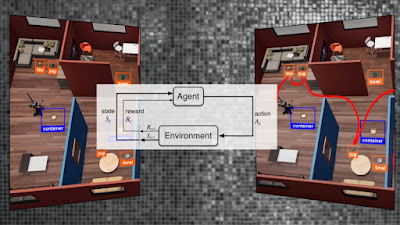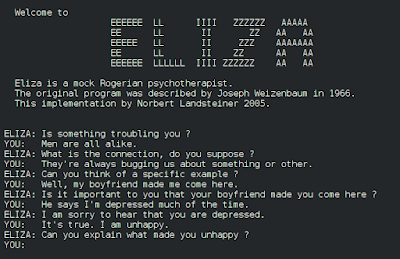Embodied Artificial Intelligence is a method for developing AI that is both theoretical and practical.
It is difficult to fully trace its his tory due to its
beginnings in different fields.
Rodney Brooks' Intelligence Without Representation, written
in 1987 and published in 1991, is one claimed for the genesis of this concept.
Embodied AI is still a very new area, with some of the first references to it dating back to the early 2000s.
Rather than focusing on either modeling the brain (connectionism/neural
net works) or linguistic-level conceptual encoding (GOFAI, or the Physical
Symbol System Hypothesis), the embodied approach to AI considers the mind (or
intelligent behavior) to emerge from interaction between the body and the
world.
There are hundreds of different and sometimes contradictory approaches to interpret the role of the body in cognition, the majority of which utilize the term "embodied."
The idea that the physical body's
shape is related to the structure and content of the mind is shared by all of
these viewpoints.
Despite the success of neural network or GOFAI (Good Old-Fashioned Artificial Intelligence or classic symbolic artificial intelligence) techniques in building row expert systems, the embodied approach contends that general artificial intelligence cannot be accomplished in code alone.
For example, in a tiny robot with four motors, each driving
a separate wheel, and programming that directs the robot to avoid obstacles,
the same code might create dramatically different observable behaviors if the
wheels were relocated to various areas of the body or replaced with articulated
legs.
This is a basic explanation of why the shape of a body must
be taken into account when designing robotic systems, and why embodied AI
(rather than merely robotics) considers the dynamic interaction between the
body and the surroundings to be the source of sometimes surprising emergent
behaviors.
The instance of passive dynamic walkers is an excellent
illustration of this method.
The passive dynamic walker is a bipedal walking model that
depends on the dynamic interaction of the leg design and the environment's
structure.
The gait is not generated by an active control system.
The walker is propelled forward by gravity, inertia, and the
forms of the feet, legs, and inclination.
This strategy is based on the biological concept of
stigmergy.
- Stigmergy is based on the idea that signs or marks left by actions in the environment inspire future actions.
AN APPROACH INFORMED BY ENGINEERING.
Embodied AI is influenced by a variety of domains. Engineering and philosophy are two frequent methods.
Rodney Brooks proposed the "subsumption
architecture" in 1986, which is a method of generating complex behaviors
by arranging lower-level layers of the system to interact with the environment
in prioritized ways, tightly coupling perception and action, and attempting to
eliminate the higher-level processing of other models.
For example, the Smithsonian's robot Genghis was created to
traverse rugged terrain, a talent that made the design and engineering of other
robots very challenging at the time.
The success of this approach was primarily due to the design
choice to divide the processing of various motors and sensors throughout the
network rather than trying higher-level system integration to create a full
representational model of the robot and its surroundings.
To put it another way, there was no central processing
region where all of the robot's parts sought to integrate data for the system.
Cog, a humanoid torso built by the MIT Humanoid Robotics
Group in the 1990s, was an early effort at embodied AI.
Cog was created to learn about the world by interacting with
it physically.
Cog, for example, may be shown learning how to apply force
and weight to a drum while holding drumsticks for the first time, or learning
how to gauge the weight of a ball once it was put in Cog's hand.
These early notions of letting the body conduct the learning
are still at the heart of the embodied AI initiative.
The Swiss Robots, created and constructed in the AI Lab at
Zurich University, are perhaps one of the most prominent instances of embodied
emergent intelligence.
Simple small robots with two motors (one on each side) and
two infrared sensors, the Swiss Robots (one on each side).
The only high-level instructions in their programming were
that if a sensor detected an item on one side, it should move in the other
direction.
However, when combined with a certain body form and sensor
location, this resulted in what seemed to be high-level cleaning or clustering
behavior in certain situations.
A similar strategy is used in many other robotics projects.
Shakey the Robot, developed by SRI International in the
1960s, is frequently credited as being the first mobile robot with thinking
ability.
Shakey was clumsy and sluggish, and he's often portrayed as
the polar antithesis of what embodied AI is attempting to achieve by moving
away from higher-level thinking and processing.
However, even in 1968, SRI's approach to embodiment was a
clear forerunner of Brooks', since they were the first to assert that the
finest reservoir of knowledge about the actual world is the real world itself.
The greatest model of the world is the world itself,
according to this notion, which has become a rallying cry against higher-level
representation in embodied AI.
Earlier robots, in contrast to the embodied AI software,
were mostly preprogrammed and did not actively interface with their environs in
the manner that this method does.
Honda's ASIMO robot, for example, isn't an excellent
illustration of embodied AI; instead, it's representative of other and older
approaches to robotics.
Work in embodied AI is exploding right now, with Boston
Dynamics' robots serving as excellent examples (particularly the non-humanoid
forms).
Embodied AI is influenced by a number of philosophical
ideas.
Rodney Brooks, a roboticist, particularly rejects
philosophical influence on his technical concerns in a 1991 discussion of his
subsumption architecture, while admitting that his arguments mirror
Heidegger's.
In several essential design aspects, his ideas match those
of phenom enologist Merleau-Ponty, demonstrating how earlier philosophical issues
at least reflect, and likely shape, much of the design work in contemplating
embodied AI.
Because of its methodology in experimenting toward an
understanding of how awareness and intelligent behavior originate, which are
highly philosophical activities, this study in embodied robotics is deeply
philosophical.
Other clearly philosophical themes may be found in a few
embodied AI projects as well.
Rolf Pfeifer and Josh Bongard, for example, often draw to
philosophical (and psychological) literature in their work, examining how these
ideas intersect with their own methods to developing intelligent machines.
They discuss how these ideas may (and frequently do not)
guide the development of embodied AI.
This covers a broad spectrum of philosophical inspirations,
such as George Lakoff and Mark Johnson's conceptual metaphor work, Shaun
Gallagher's (2005) body image and phenomenology work, and even John Dewey's
early American pragmatism.
It's difficult to say how often philosophical concerns drive
engineering concerns, but it's clear that the philosophy of embodiment is
probably the most robust of the various disciplines within cognitive science to
have done embodiment work, owing to the fact that theorizing took place long
before the tools and technologies were available to actually realize the
machines being imagined.
This suggests that for roboticists interested in the strong
AI project, that is, broad intellectual capacities and functions that mimic the
human brain, there are likely still unexplored resources here.
You may also want to read more about Artificial Intelligence here.
See also:
Brooks, Rodney; Distributed and Swarm Intelligence; General and Narrow AI.
Further Reading:
Brooks, Rodney. 1986. “A Robust Layered Control System for a Mobile Robot.” IEEE Journal of Robotics and Automation 2, no. 1 (March): 14–23.
Brooks, Rodney. 1990. “Elephants Don’t Play Chess.” Robotics and Autonomous Systems 6, no. 1–2 (June): 3–15.
Brooks, Rodney. 1991. “Intelligence Without Representation.” Artificial Intelligence Journal 47: 139–60.
Dennett, Daniel C. 1997. “Cog as a Thought Experiment.” Robotics and Autonomous Systems 20: 251–56.
Gallagher, Shaun. 2005. How the Body Shapes the Mind. Oxford: Oxford University Press.
Pfeifer, Rolf, and Josh Bongard. 2007. How the Body Shapes the Way We Think: A New View of Intelligence. Cambridge, MA: MIT Press.














